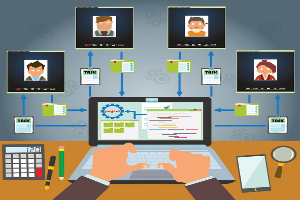
Question: We’ve transitioned to a remote-first workforce. How can we keep our employees and managers engaged with video meetings and messaging apps—especially those employees that are missing the social aspects of working together physically?
Answer: Even with video conferencing and messaging apps, fully involving remote employees in team and company meetings remains a challenge. There may be no replacing the experience of being physically in the room, but you can take steps to make these meetings more productive and inclusive.
The most important thing to remember when “meeting” with remote employees is that you can’t conduct the meeting in the same way as you normally do when everyone is physically present. You have to find a way to replace the advantages that close proximity has, especially the ease of reading body language and picking up social cues. These, unfortunately, do not translate well over the screen or the phone. So, what can you do?
What remote employees need to fully participate in meetings is space and time to speak. You can provide this space and time in a few ways. First, if there are some physically present participants, ask them to pause for a second before jumping into the conversation. This gives remote employees time to get a word in, plus it helps counter any time delays caused by the conferencing technology. Second, whoever is leading the meeting should regularly invite remote employees to add anything if they have something to say, preferably before moving on in the agenda. Third, when possible, have a remote employee lead the meeting or a section on the agenda. This focuses attention on the remote speakers and can help remind everyone that the meeting isn’t just happening in the physical room. Finally, if a group of remote employees are located in the same workspace, occasionally setting their site as the physical meeting space can help your non-remote employees get a feel for the challenges of being remote during a meeting.
Some preliminary work before the meeting can also help make the meeting itself more efficient. First, test any systems ahead of time so that they’re working for everyone when the meeting starts. Second, email the agenda out so everyone knows what to expect. Third, assign someone in the meeting room to be the contact person that remote employees can email or message if they have questions, concerns, or issues.
After the meeting, check in with any remote employees and ask them to be candid about their experience. What worked well and what could be improved? See what you can do to accommodate them in the next meeting.
You may not be able to fully replicate the experience of physically being in the room but taking these steps can enable remote employees to feel more involved and make the meeting itself run more smoothly.
This Q&A was provided by Mineral, powering the UST HR Workplace. Have HR questions? Sign your nonprofit up for a FREE 60-day trial here. As a UST member, simply log into your Mineral portal to access live HR certified consultants, 300+ on-demand training courses, an extensive compliance library, and more.

In the latest rendition of UST Live, we were joined by thought leaders from across the U.S. with expertise in succession planning. Guest moderator, Jennifer Hutchins from the Maine Association of Nonprofits, lead the conversation as the group discussed how organizations nationwide are experiencing a shift in the workforce as employees seek out other opportunities. Whether a transition occurs due to an unexpected vacancy or the anticipated departure of a long-tenured leader, it’s vital that nonprofits have a succession plan in place to ensure organizational sustainability.
The group also discussed why proactively addressing how your leadership needs will evolve in the future and identifying activities to strengthen leadership capacity can help create the resiliency and agility an organization needs to thrive.
Watch now to discover:
Upcoming UST Live Webinars: This webinar series was designed to equip nonprofits with the strategies and resources they need to survive (and thrive) in a constantly evolving environment. Be on the lookout for future UST Live sessions—scheduled for November.

If you want to be an effective leader, you must have strong communications skills and a good amount of composure. In today’s workforce, the only thing that separates one leader from the next, is how they communicate, handle conflict, and lead. Being a team leader can be an incredibly rewarding role but it comes with its challenges. And while handling difficult conversations may be the least appealing part of managing employees, it’s an important part of leadership that every manager should be prepared for—whether it’s about poor performance, attendance, peer conflict, or behavioral issues, these conversations are ultimately inevitable in any workplace dynamic.
It’s common for defenses to be high when having a difficult conversation, so it’s imperative that you have a plan for when they come about. Prepare ahead of time and pick a neutral time when it’s calm. Go into the conversation with an open mind and ready to listen. It takes a nanosecond to invoke defensiveness—employees may respond with a blank stare, a passive sigh, or even an angry rebuttal so be clear and concise, using non-defensive communication while also being professional and friendly in nature. Poor communication can affect morale, performance goals, and sales so take some time to ensure you know the facts and have a plan for whatever response you may get.
Below are some do’s and don’ts on how to effectively (and respectfully) navigate difficult conversations in the workplace while maintaining morale, fostering trust, and maximizing productivity.
Difficult conversations can be awkward and unpleasant but with some thoughtful tactics in your back pocket, you can successfully address a tough situation and find effective solutions to whatever issues may arise while also ensuring you maintain respect with your team.

Working on a team requires more than just hard work, morale amongst co-workers, and willingness to work with others. The most important yet often ignored that attributes to a team’s success is effective communication. Communication is a vital part of any business environment—especially a nonprofit organization since many employees wear multiple hats—as it facilitates a consistent flow of information. When it comes to team communication, the purpose of interacting among co-workers is to share information that is essential to achieving organization goals. In addition, good communication makes it easy for team members to coordinate with one another effectively.
An organization’s communication strategy usually consists of techniques that encourage open communication and effective teamwork in a workplace environment. Having an action plan in place for your organization can help to improve your communication skills, work on team building, and executive tasks efficiently. This kind of proactive leadership is even more important today, given the rise of remote teams and virtual collaboration.
Here’s just a few of the many benefits that result from an effective communication strategy:
1) Supports Employee Engagement: Effective communication in the workplace increases employee morale and engagement by helping team members feel connected to the work they’re doing and the organization their working for. Thoughtful team-building activities can also help nurture communication skills, which improves camaraderie and employee engagement. Increasing employee engagement can lead to reduced turnover, a better customer experience, and even increased profitability
2) Helps with Productivity: Inefficient work habits or missed project deadlines are almost always the result of poor workplace communication skills. By using effective communication strategies, you can be clearer about expectations and ultimately get the results you need to deliver projects in a timely manner.
3) Opens Up Doors for Innovation Opportunities: An environment of open communication in the workplace fosters creative problem solving, more adventurous ideas, and out-of-the-box thinking. It helps you create space for innovation by fostering a “no bad ideas” attitude and encouraging your team to try new things—even if those projects don’t work out as anticipated. Making space to learn from different collaboration styles can really expand the possibilities for your organization.
Effective communication in the workplace might sound straightforward but it’s about so much more than having a simple conversation—especially when not everyone communicates the same way. You need to be intentional and use the right strategies that provide diverse opportunities for both formal and informal communications across the organization. By employing communications strategies that foster open communication and collaboration, you can build an organization full of employees who are engaged, efficient, and innovative. And that’s the kind of team that makes an organization successful and most importantly, support the communities you serve.

Question: Can I ban cell phones at work? How about audio and video recordings?
Answer: This question has brought up issues that have been the subject of recent litigation, so it’s a great time to be asking.
To answer your first question: yes, you can limit or even prohibit use of cell phones during work hours. Employees can be expected to give their undivided attention to the work you pay them to perform, and if that means cell phones need to be turned off or put away, you are entitled to make this request. However, employees should be allowed to use cell phones during their break and meal periods, as this time needs to be truly their own in order to satisfy the requirements of state law. Fair warning: if you attempt to prohibit cell phone use during all non-break time, you may receive some fairly aggressive push back. A more lenient policy may do the trick. Typical standard language says, “Personal cell phone use should be kept to a reasonable limit during working hours. Reasonableness will be determined by your manager.” This language gives your managers considerable discretion, but they should be trained to use the same standard of reasonableness for all employees to avoid claims of discrimination.
To answer your second question: no, audio, video, and photography cannot be strictly prohibited, but they can be limited. The National Labor Relations Board, which enforces the National Labor Relations Act, has said that employers cannot outright prohibit recordings as this could interfere with employees’ ability to organize with respect to their terms and conditions of employment. For instance, employees might choose to record a conversation during their lunch hour related to asking for raises and want to share that recording with employees who work different shifts. This would need to be allowed. However, you can still have a policy that prevents recording (via audio, video, or photograph) confidential information, such as proprietary business practices, customer lists, client or patient information, or employees’ personal information. Be aware that you cannot deem all information confidential, e.g. “all conversations in the office” or “anything related to customer/patient care.”
If you feel it is important to have such a policy, you may say something like, “Audio and video recording devices, including cameras and smartphones, may not be used to record or capture any confidential information, whether it is proprietary business information or clients’ or employees’ confidential personal information. If recording non-confidential information, e.g. taking photos of colleagues, please seek the consent of all parties to the recording.” A policy like this can be added to your handbook during your next handbook review, or if you feel the need is urgent, you can distribute it to all employees now and have them sign an acknowledgment form.
This Q&A was provided by Mineral, powering the UST HR Workplace. Have HR questions? Sign your nonprofit up for a FREE 60-day trial here. As a UST member, simply log into your Mineral portal to access live HR certified consultants, 300+ on-demand training courses, an extensive compliance library, and more.

Leadership development is an attractive benefit that is becoming commonplace in the current job market. About half of Millennials expect their company to help pay for leadership training, and 60% say they’d prefer a job that provides professional development over one that provides regular pay raises.
How Know-How Helps
First, employees want to gain mastery over current job and life challenges. But then, one in five will leave their current position in search of a job that provides additional professional development opportunities. Nearly a third of workers say education would help them feel more engaged and loyal. Yet fewer than half of businesses offer leadership training. Even fewer offer mentoring or career counseling. Think about offering all that with these four levels of staff development.
Try to make education an ongoing process with multiple built-in opportunities. On-the-job training can be the most cost-effective approach for smaller organizations. Coaching fosters teamwork and saves funds by working internally. Leadership education is important to succession planning as well as retention. Whatever their path, give employees the opportunity to practice and implement the skills and knowledge they have gained.
Leadership Realities
In the past, businesses had two ways of moving people up to leadership levels: Climbing the ladder through promotions or following a career path that included educational leadership development. Today’s post-recession workers feel the need to protect their careers from further economic downturns by staying employed where they can receive training and development. In a tight market, you should expect to include some training in their benefits package. The best practice for this situation is to make an effort to align their leadership development with the anticipated needs of your nonprofit.
Your nonprofit might be overdue in training new leaders. Baby Boomers who started organizations decades ago are retiring or preparing to retire from their leadership positions. Add to that, about half of current young professionals will leave the nonprofit sector. If you’re facing an upcoming leadership crisis, by all means focus on leadership training. Your workforce will enjoy a successful career path, and your nonprofit will benefit from well-trained leaders who know how to take your organization forward.
Development 101: Begin Simply
One of the best ways to offer career development is to build leadership skills through practical hands-on experience. It will help your managerial staff to know their organization well so encourage managers to delegate and coach where needed in order to build a list of success stories. Some cost-effective ideas to start you in the process include:
A Sensible Approach
While you’re considering how to best juggle all the possible educational benefits, take a pragmatic look at the costs. There’s a simple formula you can use to maximize educational effectiveness without breaking the budget. The Center for Creative Leadership promotes a cost-effective model for leadership development that you should consider:
Many nonprofits fail to follow this guiding principle and the result is often an unfocused, unsuccessful training program that does little more than pay lip service to the idea of leadership development.
Make Mentoring Happen
Do your managers notice emerging leaders in their teams? You can design a formal mentoring program or keep it informal, as you see fit. Make sure they have a safe space to learn so that they can accelerate learning. Allow time during work for mentoring sessions. If your nonprofit cannot support an internal mentoring program, you may be able to partner with other local organizations and businesses for potential mentors. Resources include the Aspire Foundation, which provides global, free online mentoring to women working in nonprofits. Search online to find the numerous mentor-training resources available.
Affording Formal Training
As you know, finding adequate funds for your training initiatives can be a challenge. There are ways to leap past those hurdles. Here are some possible means of funding formal leadership development in your nonprofit:
Funds spent on leadership training provide high returns on investment (ROI). And this ROI isn’t just fiscal. It’s a great way to increase your mission impact, bring in higher revenues, control costs and provide for greater stability as you build employee loyalty. Strengthen your training programs to focus on success in achieving leadership roles, and employees will stay as they reach for the heights of leadership succession.
Logic Dictates
A recent study showed that only a third of nonprofit executives rose through the ranks of their organization. If two-thirds of nonprofits are having to hire executives from outside, that suggests they lack appropriate leadership development. They may even be neglecting larger strategic issues. The results of this lack of focused strategy means that nonprofits are not rising to meet the challenge of diversifying their leadership in race, ethnicity, or educational background. It’s critical that they improve their ability to groom talent from within.
You may experience push-back from an executive who doesn’t want to dedicate resources to leadership development. The truth is, some leaders dislike the idea of training their replacements. It makes them feel that their time is coming to an end. If that’s true in your nonprofit’s case, you will need to explain that a strong leader is someone who prepares for the inevitable, which includes future changes. It will likely help if your organization’s board of directors makes succession planning a part of the job description for all executives. A legacy can be ruined by leadership succession that is ill-planned. Instead, your executive has the opportunity to make an enduring mark on your organization by leaving it in capable hands.
And, often, the best way to do this is to promote from within.
This is an excerpt from UST’s eBook, “Innovative Strategies That Overcome Nonprofit Retention Barriers” in collaboration with Beth Black, Writer and Editor.
If you’d like to see more content like this, check out UST’s Content Library that houses our most popular nonprofit resources, including on-demand webinars, toolkits, eBooks, guides, & more!

As a nonprofit leader, when it comes to the future of your workforce, focusing on skills is an essential step. However, many upskilling strategies are missing the mark. The confusion often starts with a lack of understanding the difference between upskilling, reskilling and cross-skilling—the lines tend to blur and identifying the role of each will better equip your organization to prepare for the future of work. While both upskilling and reskilling are about learning new skills, the context for each is a bit different. Upskilling is focused on helping employees become more knowledgeable and develop new competencies that relate to their current position while reskilling is about equipping workers to switch lanes and move into new roles within your organization. Cross-skilling is the process of developing skills that are valuable across multiple functions.
There’s no denying that upskilling and reskilling initiatives require a significant investment, in both money and time. Superior approaches generally include both compelling content as part of a Learning and Development (L&D) curriculum, as well as experimental opportunities such as mentoring and projects. Given the effort upskilling and reskilling require, some might wonder if it might just be easier to prioritize external hiring. While it might sound like a simpler strategy on the surface, turning to new talent won’t solve your skill-building concerns. Even if your organization manages to recruit employees with the necessary skills, these recruits will need to build new capabilities in the future. Since the pace of change is accelerating, offering opportunities for upskilling and reskilling has become unavoidable this day in age.
When determining the best form of training for your employees, it can depend on the permanency of their positions. It would be a poor use of resources to invest in the professional development of an employee whose role is becoming obsolete. Upskilling tends to benefit positions that can easily evolve with the organization, while reskilling is perfect for helping employees of changing departments get ready for entirely new workplace obligations. Organizations that are content with their current staff can use upskilling to continuously help their employees develop their qualifications without reassigning them a different position. You can help support your staff grow as professionals by providing them with enriching training opportunities while maintain an effective forward-thinking team in the workplace.
Taking into account the skill set of your team, your organization can then determine if a particular employee will remain in their current position or if their capabilities will be more beneficial in another area of the organization. Staff members who exceed the organization’s expectations in their department and have proved to be excellent leaders should undergo reskilling to prepare them for a promotion. Where a promotion isn’t an option, perhaps they could make a lateral move, in which their salary and hierarchy stay the same but their position changes. Employees who would benefit from honing their existing abilities can do so through upskilling programs.
Upskilling and reskilling your professionals will have significant impact on their careers. Offering either form of training to an employee can develop their professional skills and position them as a valuable member of your organization. Businesses that understand the benefits of both processes will help their employees find success in whichever position and responsibilities they undertake.

Question: What are effective ways to manage remote employees and monitor their work?
Answer: Managing remote employees can certainly be a challenge. Here are some of the practices we recommend:
This Q&A was provided by Mineral, powering the UST HR Workplace. Have HR questions? Sign your nonprofit up for a FREE 60-day trial here. As a UST member, simply log into your Mineral portal to access live HR certified consultants, 300+ on-demand training courses, an extensive compliance library, and more.

Nonprofit workers strive to make the world a better place. However, these passionate professionals often face long working hours, limited resources, funding deficiencies and an unrelenting stream of other on-the-job challenges. All this and more can lead to employee burnout, as well as nonprofit compassion fatigue.
How can nonprofit employees of all levels better address such difficulties and avoid becoming overly strained? Below are some actionable ideas to help prevent employee burnout and work toward a healthier work-life balance.
First, what is nonprofit compassion fatigue and what does it look like? Referred to at times as secondary trauma or vicarious trauma, compassion fatigue is a way to describe the excessive stress affecting those exposed to the traumatic suffering of others leading to desensitization, indifference or apathy. When untreated, it could lead to exhaustion, irritability, reduced productivity and absenteeism, along with physical and mental health problems.
Essentially, compassion fatigue means that a person working continuously under strenuous conditions no longer feels able to care about the people they serve. Often, these individuals get to this point by minimizing their own suffering. In fact, industry reports have found that 62% of people who engage in emotional work tend to hide their personal feelings. Combine this with being buried in work and these people can easily develop feelings of helplessness and hopelessness.
Over time, this not only affects an employee’s health and relationships, but it can significantly impact employee retention. A 2021 study found that 69% of participants believe their organizations are understaffed. Chronic staffing issues ultimately whittle away at a nonprofit’s ability to achieve objectives.
What can leaders and HR professionals do to address compassion fatigue and burnout? It starts by implementing a strategy designed to promote a healthy work culture. Everyone should be encouraged to capitalize on vacation time, lunch breaks and time off-the-clock to de-stress from the important work they are striving to accomplish. Leaders should also establish and enforce reasonable work hours.
Another way to help address arduous workloads is to create a prioritization system for projects and tasks. While the job market is understandably in flux, efforts should be made to hire more staff or recruit additional volunteer support.
Lastly, open the door to enhanced communication strategies. Extend genuine thanks to the staff and encourage honest feedback, anonymous or otherwise. Not only are these methods more sustainable, but, in the end, they can generate greater employee engagement, retention and job satisfaction.
For employees, to avoid becoming burnt out and feeling powerless, it’s advised to utilize vacation time and take regular breaks. By “unplugging” during the day — even if it’s only a short break — it’s possible to reduce stress, gain perspective and feel more in control. Also, learn to say “no” without feeling guilty. Setting clear boundaries on messaging after hours, task delegation and more could do wonders for future productivity.
To learn more about combating nonprofit employee burnout, please see the accompanying resource.
Resources:
https://www.qgiv.com/blog/how-to-overcome-nonprofit-burnout-and-compassion-fatigue/
https://www.keela.co/blog/nonprofit-resources/3-leading-causes-of-nonprofit-burnout
https://www.idealist.org/en/careers/recognizing-compassion-fatigue-helping-professions

A major shift has been underway, fundamentally altering, when, where, and how work occurs. As organizations adjust to today’s new hybrid workplace, collaboration among team members who aren’t co-located is emerging as the primary way to get things done. This way of working brings new opportunities—along with new uncertainties and challenges—for those leading the hybrid workforce. Effective hybrid workplace leadership requires building cohesion among colleagues working together from different locations, fending off burnout, being intentional about inclusion, and strengthen shared culture.
The nonprofit workforce has evolved in ways no one could have foreseen, and leaders continue to adapt to a changing management style. Forced to re-invent not just how they worked, but where, many are embracing hybrid teams—a blended model of in-person and remote workers. For some leaders, the shift to managing hybrid teams is a radical departure from business as usual but with the right use of technology, strong communication, and clear expectations, hybrid teams can be highly effective. Nonprofit leaders can utilize UST’s 5 Tips for Successfully Leading a Hybrid Workforce to ensure productivity and engagement. These essential tips include:
The pressure is on leaders to find innovative solutions to make hybrid teams happy and productive as the hybrid model can be more complicated than a fully remote team. Take this opportunity to pay close attention to your team and continue to find ways to address their unique position. To successfully manage a hybrid workforce, leaders must create processes, build trust, and ensure a strong shared experience across all teams. Sign up for our monthly eNews to continue receiving helpful insights, how-to-guides, and legal updates specific to nonprofits!

UST maintains a secure site. This means that information we obtain from you in the process of enrolling is protected and cannot be viewed by others. Information about your agency is provided to our various service providers once you enroll in UST for the purpose of providing you with the best possible service. Your information will never be sold or rented to other entities that are not affiliated with UST. Agencies that are actively enrolled in UST are listed for review by other agencies, UST’s sponsors and potential participants, but no information specific to your agency can be reviewed by anyone not affiliated with UST and not otherwise engaged in providing services to you except as required by law or valid legal process.
Your use of this site and the provision of basic information constitute your consent for UST to use the information supplied.
UST may collect generic information about overall website traffic, and use other analytical information and tools to help us improve our website and provide the best possible information and service. As you browse UST’s website, cookies may also be placed on your computer so that we can better understand what information our visitors are most interested in, and to help direct you to other relevant information. These cookies do not collect personal information such as your name, email, postal address or phone number. To opt out of some of these cookies, click here. If you are a Twitter user, and prefer not to have Twitter ad content tailored to you, learn more here.
Further, our website may contain links to other sites. Anytime you connect to another website, their respective privacy policy will apply and UST is not responsible for the privacy practices of others.
This Privacy Policy and the Terms of Use for our site is subject to change.
UST maintains a secure site. This means that information we obtain from you in the process of enrolling is protected and cannot be viewed by others. Information about your agency is provided to our various service providers once you enroll in UST for the purpose of providing you with the best possible service. Your information will never be sold or rented to other entities that are not affiliated with UST. Agencies that are actively enrolled in UST are listed for review by other agencies, UST’s sponsors and potential participants, but no information specific to your agency can be reviewed by anyone not affiliated with UST and not otherwise engaged in providing services to you except as required by law or valid legal process.
Your use of this site and the provision of basic information constitute your consent for UST to use the information supplied.
UST may collect generic information about overall website traffic, and use other analytical information and tools to help us improve our website and provide the best possible information and service. As you browse UST’s website, cookies may also be placed on your computer so that we can better understand what information our visitors are most interested in, and to help direct you to other relevant information. These cookies do not collect personal information such as your name, email, postal address or phone number. To opt out of some of these cookies, click here. If you are a Twitter user, and prefer not to have Twitter ad content tailored to you, learn more here.
Further, our website may contain links to other sites. Anytime you connect to another website, their respective privacy policy will apply and UST is not responsible for the privacy practices of others.
This Privacy Policy and the Terms of Use for our site is subject to change.